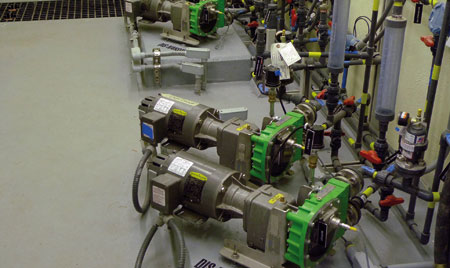The ever-expanding Seneca wastewater treatment plant in Eagan, MN required a pump capable of accurately dosing 15 percent sodium hypochlorite ("hypo").
Hypo has outstanding disinfection properties and is used in wastewater treatment to kill off bacteria before being discharged back in the environment and in water treatment as one the primary methods of drinking water disinfection. It can also be a challenging product to pump. Hypo tends to off-gas, causing some pump types to vapor lock-particularly diaphragm pumps-and can also be chemically aggressive depending on the concentration.
After evaluating several pump choices, the engineers for the expansion to the Seneca facility chose a peristaltic hose pump. Ten pumps were put to immediate use in a new area of the treatment plant. A wastewater plant needs to run as cost efficiently as possible, and the plant personnel were impressed with the long hose life and ease of maintenance in changing the hose. Each pump achieves flow rates up to 48 gph at pressures up to 175 psi. The pumps can pump both gas and liquid, ensuring the liquid stream receives a consistent dose.
Peristaltic Pump Details
The fluid dosed is totally enclosed within the flexible hose, as a rotating shoe compresses the hose completely to move the liquid. After the liquid moves, the resulting vacuum caused by the restitution of the hose back to its original size draws in more liquid. This process, called peristalsis, makes the peristaltic pump an ideal option for liquid metering as a set volume is delivered with every revolution. Variations in hose materials allow for a variety of low and high strength hypo dosing.
The nature of the pumping process used by peristaltic pumps results in sealless operation with only the hose coming in contact with the pumped fluid. Not only does this mean that the pump is hygienic and leak free, but it also means that no moving parts become clogged or damaged. The only maintenance required is changing the hose, which is done quickly and efficiently, keeping downtime to an absolute minimum. This saves costs and increases profits.
Several other applications in water and wastewater industries are ideal for peristaltic pumps. Lime, Kalic® or Kalkmilch are ideally dosed by these products. The chemicals are used to rectify the pH of wastewater discharges and are particularly abrasive, creating continual wear problems for other technologies like progressing cavity pumps where moving parts come in close contact with each other. This can lead to high spares costs (rotor and stator) and result in frequent maintenance downtime. Lime can also be relatively viscous-generally too viscous or abrasive for technologies such as diaphragm pumps, causing them to clog and become highly maintenance dependent.
Peristaltic pumps are abrasion resistant and ensure the smooth passage of the liquid regardless of its properties. In fact, the same hose life can be achieved while pumping either an abrasive slurry, a clean fluid or even air-as long as the process conditions remain constant (flow rate, discharge pressure). Their design also presents no opportunity for the product to settle as the peristaltic action keeps the product in suspension. Furthermore, the product can be mixed onsite as solids in the liquid stream do not present a problem for the pumps. They also have a linear flow-speed characteristic ideal for feedback control systems, allowing precise control of the chemicals being dosed, minimizing chemical usage.
Ferric Chloride and polymer dosing are other common applications. These additives are used in clean water plants to remove peat, suspended solids and residual colors from clean water streams. In wastewater treatment, sophisticated polymers maximize plant throughput by increasing the solid separation rate, allowing the treatment of greater primary waste volumes.

As peristaltic pumps are true positive displacement pumps, they will deliver a consistent flow rate as the discharge pressures vary.
Most polymers are highly shear sensitive, but this is not a problem for the peristaltic pump. Gentle pumping action ensures that shear sensitive solids and liquids are not damaged or altered, a common problem with other designs. Allowing polymer to gently pass through the pump without being damaged results in a more complete and intact chain, which means less polymer is required to maintain effectiveness.
All water treatment plants produce waste, which has to be prepared for disposal. A filter press is typically used to minimize volumes and reduce waste processing costs. Such equipment presents a challenge to traditional pumping solutions as the water is abrasive, and with high flow rates can result in increased wear on the pump.. Traditional pumps are often fitted with expensive and pressurized mechanical seals in an effort to protect the drive portion from the pumped fluid. As the process proceeds, the pressures generally increase through the press, which makes mechanical sealing more difficult, and can result in seal leakage and failure.
As peristaltic pumps are true positive displacement pumps, they will deliver a consistent flow rate as the discharge pressures vary, versus other technologies (centrifugal and diaphragm) where flow and efficiency drop off with increases in pressure. Also, variable suction conditions (due to changes in NPSH caused by liquid levels rising and falling) inevitably result in this type of process, and "rat holes" can appear in the filter press feed as water is pulled from above the top of the sludge blanket. This increases the water content and the volume of the pressed waste, increasing operation costs. Peristaltic pumps have a consistent suction performance and also superior lift characteristics as compared to other pump technologies, which reduce the likelihood of problems occurring on the suction side, making them an optimal solution for filter press applications.
Pumps & Systems, March 2010

